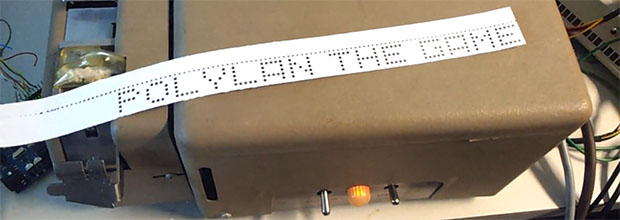
Back before the days of 8 inch floppy disks, storing computer programs was much more primitive than even a stack of punch cards. The earliest general purpose computers used paper tape, a strip of paper with punched holes designating a 0 or a 1. Thankfully for the computer scientists of the day, these paper tapes weren’t created by hand. No, the Friden SP-2 tape punch took care of the duties of punching holes in these tapes. When [Max] rescued one of these tape punch machines from a trash bin, he knew what he needed to do: connect it to an Arduino so he could create his own paper tapes.
[Max] found a veroboard with a bunch of transistors inside the machine that was added by a previous owner. After finding the manual for the machine he connected it to an Arduino, holding each of the eight control pins high to punch the tape, and then holding another pin high to advance the tape. With this, he was able to punch letters instead of binary code into his paper tape.
[Max] also added an Ethernet shield to his Arduino that checks his email. If an email shows up in a special folder, it outputs the subject line to the tape punch machine, giving him an entirely retro ticker tape machine, built with vintage 60s hardware.
There are a pair of videos of [Max]’s tape punch machine in action below, along with a gallery of the glamorous gut shots of this incredible machine.

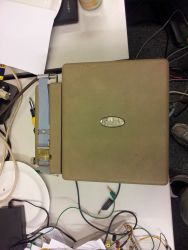
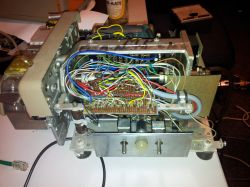

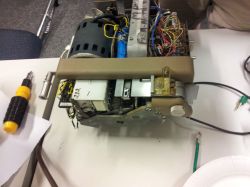

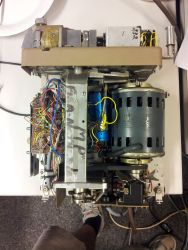















Reminds me of the autotype from Sanctuary, very neat.
Now he needs to build a tape reader.
Would be a pretty simple task, just advance the tape from one spool to another with a stepper, pass it through a row of opto couplers.
That level of complexity isn’t required, only the row of phototransistors is. Back in the late 70s there were paper tape readers advertized in Byte that consisted of little more than the phototransistor array and two guides on a PCB, connecting to a parallel port. The tape was read as fast as it could be pulled through by hand, and it did not even need to be constant. Byte or Kilobaud magazine had an article on building one (with I recall a circuit diagram with one or two chips) for about $20.
it was Byte, (have the issue)
but you could buy them for next to nothing.
there is a row of sprocket holes for the tape punch/reader to pull the tape through, that gets used as the “data valid” or clock pulse with the optical reader
the KYM-1, SYM-1, AIM-65 all had paper tape read, I use it with a terminal session to save and load files on my SYM-1
The tape punches MDSI used to sell with the CompactII systems had integrated readers on the front of them, The Compact II systems were rebranded Data General Nova systems, but I dont know who made the Punches. The interface was RS232. Don’t rember the bit rate for them though, fairly low.
These machines were frequently used to write text back in the days, the tape identifier (name of the program or serial number, extra information etc) was often written using the punch machine.
I found a PCB drill machine program on punch tape, the PCB name and all the drill numbers and sizes were printed in clear text using the punch, for the operator who would be setting up the job.
If he has access to a band saw he could cut cash register paper to the proper size for this machine. @ James – It would be nice if he could find an authentic vintage tape reader and set it up. Maybe he could even use it to program an arduino!
I wonder if you could make one from scratch easily. I’m thinking a lever that goes lateral to select a position for the hole, operated by servo maybe, then a solenoid to punch the hole perhaps, because having tons of solenoids is harder since they tend to be big and not really that cost effective, and they draw relatively large amount of juice so running them parallel would cause a powering issue.
Depends how fast you want it. I’d go with parallel solenoids, I can only assume that’s what all the old-time guys did. Moving servos and whatnot is asking for mechanical trouble. Parallel solenoids means the only moving parts are the punches. Power’s really no problem, plenty of it in the mains.
If you wanted to go reeeally hi-tech, it’d be quite an amusing use of burning lasers. Have a tape punch that works in megabits / second, or miles per hour.
Power from the mains is a bit too much though in terms of voltage, and stepping down many amps comes at a cost, and looking at the manual as mentioned of the device it says: “code magnets: available for 90, 48, 24 volt D.C. operation”.
Still – I suppose a cheap computer PSU can get you quite the amperage in the 12v range that many solenoids use so I guess you got a point after all.
Primitive? its the exact same technology but easier to store and faster to load, paper tape was an improvement over a shoebox of punch cards
This takes me right back to the good old times when a tape puncher was the only way
to save the programs i had entered on a teletype terminal with a 1200/75 dial-up connection to a PDP-11. How things have changed
In reading, the smaller set of holes is used as a clock to set window and then read the next set of 8 holes. In the 8080 days they had a hobby box… photo diodes inside. You simply passed the paper strip thru the slot with a desk lamp over head to read the latest few kilobits of a program Mailed to you in a flat envelope. No ‘duino of course diodes, clean up levels, to parallel port.
My company just scrapped an old CNC mill/lathe that still had a paper tape reader on it (alhough it was upgaraded to serial and then ethernet many years ago).
The current G-code syntax and set of instructions was designed with paper tape in mind. Canned cycles and other features were meant to spare meters of paper. At the time, everything was programmed by hand (no CAM), and the difference between good code and bad code is that a single program could fit on a standard reel or not.(and of course not crashing the machining head in the table or workpiece). None of the guys at the workshop regret this time though…
60’s?? This goes back to the 40’s. I believe, the original “Colossus” computer that decoded the German Enigma coded messages was run from these paper tapes. Maybe not “exactly” the same, but about the same technology. I’m pretty sure the tape was connected in a loop, so the “program” ran in a continuous loop, decoding and decoding and decoding…
Punched tape technology is much older than the 1940s, but this particular reader dates back to the 1960s. (FYI, the Enigma ciphers were broken with machines called “Bombes”, built first by the Poles, then replicated in large quantities by NCR. Colossus came around later and was built to break the Lorenz ciphers.)
I learned to program in the 1960s and 1970s, and used a paper tape punch and reader mounted on the side of an Model 33 ASR teletype to store my programs. I’m sure I still have a few old BASIC programs on coils of paper tape in the back of a desk drawer somewhere.
Where can you get paper tape these days?
I think the company I used to work for bought out the last of the paper and mylar from the regular suppliers in the late 90’s. They overreacted when they found out it wasn’t being made anymore, and I was down to our last 3 spools.
I made a mistake on a CNC program for a large tooth count involute gear program for our WEDMs and used up an entire roll, and the program wasn’t even complete. I knew the program was long, just not that long. After that I didn’t use the macro for involute gears other than to generate the inital curve, then I would fake the involute in with 3 arcs instead, the approximation with arcs was usually under 3 millionths or so. If I could have found a curve fitting program that could get as close as I could manually tweaking the arcs I would have used it.
My parents used to have a massive war time teletype machine with the paper rolls and paper punch tape. Not sure why they continued to use the punched paper when the machine recorded everything in plain text on the rolls anyways. My parents were furious when I happened to discover the large waste bin for the chad inside the machine. What else was a five year old going to do with all that confetti?
Getting email this way is just hilarious :)
This really bring back memories. In the mid 70s I had access to an ASR-33 teletype with a built-in punch tape writer/reader which we used to store our programs. One of the many programs I wrote on that DEC PDP-8 was a BASIC program which had you enter a text string. My program would punch our the test as plain text on the paper tape. The ASR-33 teletypes were built like tanks and used in lots of places, including Navy ships and even Skylab.
If you are interested in a simple kit for 1″ 8-bit paper tape reading, you can get one from JM Precision. They made a replica OOP80a, its an easy build. I was able to get some legacy unpunched 1″ tape. Now I am just looking for something to be able to punch the tape…
In the most hilarious show of commitment to a career in computing and electronics at 18 years old (1978) I swapped my Honda moped for an OP80 paper tape reader. I had lovingly restored the Honda 2 years earlier.
Hi, can you please post the dataset for the characters as I want to embed the font into a tape punch program on my PDP8. That would allow the filename to be readable prior to the program punch. I wrote one in 1978 for a PDP11/34 but have lost it. :)